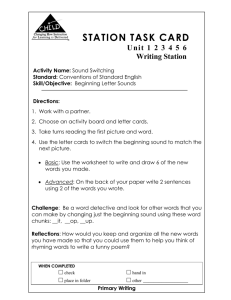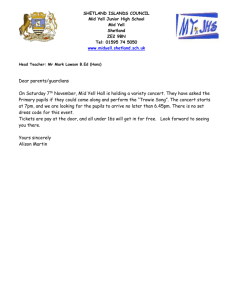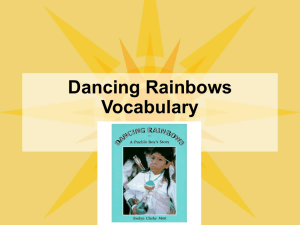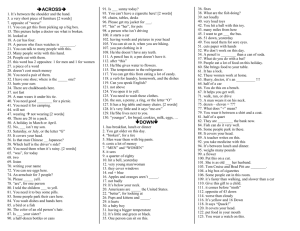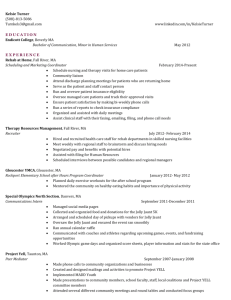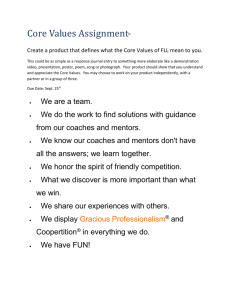Recommendations & Findings - Learning, Design and Technology
advertisement
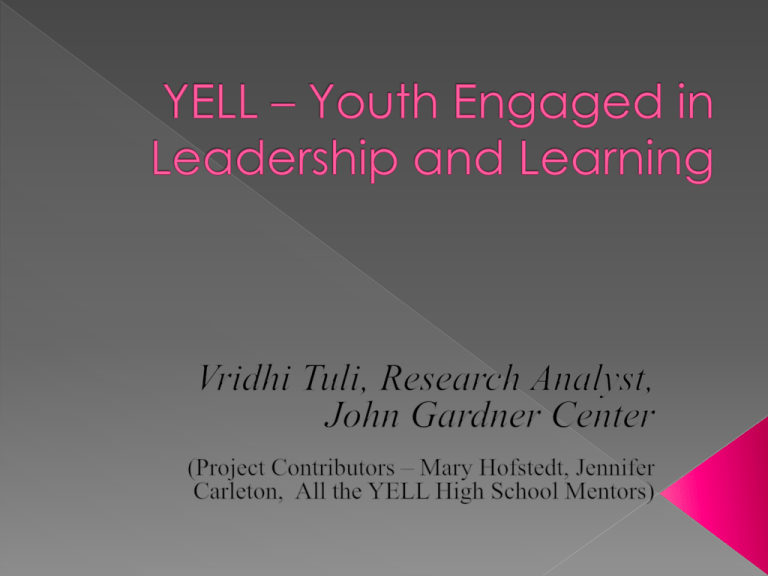
15 minutes presentation 5 minutes break 40 Minutes Space workshop with High School mentors Do you want to spend more time in class interacting with the little middle school kids during an activity? Do you want to know “what,” “why” and “how” you’re doing stuff in class? YELLStar Lesson Planners ? What are the outcomes? ? What are the indicators of success? ? How will you measure success? Do you want to spend more time with each other on field trips having your own “youth time?” Observations › Cindy’s Activity › OST Tool: “Personally Focused [can be defined as]: The activity strengthens relationships among youth and between youth and staff” › High school students were not participating with middle school students during a session as learning leaders (Concept: Peer-to-Peer learning) › Bullying and Harassment Focus Group › Wiggins and McTighe: “What would we accept as evidence that students have attained the desired understanding and proficiencies –before proceeding to plan teaching and learning experiences.” › Middle school students were task oriented and on track as Peer Evaluations We suggest for YELL: “Better communication amongst staff” “More mentors” “More Field Trips” What do you think PM and SC groups suggested? Leadership Group YELL Mentors Peer Mediation Student Council Favorite Thing Being a role model Solving student’s problems Making a choice for the school and helping school Most Important Learning Leadership, Comfortable with others Respect, Listening Leadership, Teamwork Suggestions for Improvement “Better communication amongst the staff”, “more mentors”, “more field trips” “More things to do when not mediating”, “Being more prepared”, “I want staff members to actually be there” “To have everybody listen to all great ideas”, “after school meetings to make posters”, “working as a team, more time for meetings” “Identify program quality and training/staff development needs of YD based programs at Kennedy Middle School “ (Internship Objective) “Develop 2 one hour training sessions for program staff (including high school mentors), that address staff development needs.” (Internship Objective) (ongoing) › Reviewed YELL Handbook and other YD brochures › Observed Kennedy Middle School afterschool sessions as a participant observer (once a week for 4 weeks) › Facilitated a brainstorm with high-school leaders › Analyzed student evaluations › Wrote weekly reflective logs omething like…”so what does the space and how we use the space have anything to do with any of this?” Poster Photos Cushio n YELL Classroom Area Sofa Cushio n 7th Grade Agree ments Bin Sofa Whiteboard Poster Photos Board Respect Sofa Table YELL Entry Area Micro wave Schedu le Poster Table Round Table File Cabinets Mirror Washin g Sink Bin Long Table Neighbor hood Map Poster Skill YELL Mentors want to Learn YELL Curriculum Session Time Period Introductory Communicatio n Sessions 1 (Active Listening), 4 (Working as a Team) Month 1 Sessions 8 (Speaking and Presenting), 12 (Facilitation) Month 2 LoIntermediate Communicatio n Sessions 2 (Active Listening), 5 (Working as a Team) Month 3 Sessions 9 (Speaking and Presenting), 13 (Facilitation) Month 4 Hi – Intermediate Communicatio n Sessions 3 (Active Listening), 6 (Working as a Team) Month 5 Sessions 10 (Speaking and Presenting) , 14 (Facilitation) Month 6 Advanced Communicatio n Sessions 7 (Working as Team), 11 (Speaking and Presenting) Month 7 Sessions 15 (Facilitation), 16 (Facilitation) Month 8 Research: About 1) creating respectful and structured informal learning environments, and 2) methods for facilitating deeper/more active group discussion. Also – if you can keep a mental note of which materials are particular helpful or interesting – that would be great as well. Are there pieces that you think are accessible for new program staff trying to ‘wrap their minds’ around youth development? Background Research: Youth Mapping Redwood City Demographics: Population: Latinos- > 50% Goals: Active – Decision Making Rationale: Youth – insights into school and community development Tasks Implemented: Techniques to research and collect data- Technique or decision making? Promote critical thinking about the community in surveys- Pick a community issue of interest- Water wastage important to a NGO. Create a question about it- Should there be water on the roads? E.g should we spend $5 on a new table or on food? Why? What are the benefits and costs? Give them $5 and ask them to spend it in the next one week. Youth Mapping: Group of youth learn about needs, strengths, activities of peers in community. – learned community assessment design, research skills (data collection and analysis) and advocacy skills. Plan to work together with the adults to build on the school and community strengths they identified (Adults may not understand the community- generation gap, Implementation) Mappers and neighborhoods Methods: Interviews, Survey, Community College Photos, Observations- photos, Video profile of 5 Neighborhoods Findings: › › › › › › › › › Popular Schools – Friendly Acres, Roosevelt School Family, Friends, TV/Video Games are factors most important to Youth: Youth Liked: Family Relationship, Good Friends, Watch TV/Play Video Games Why youth liked school- to be with friends or make new friends Youth are troubled when they have a weak tie with their family Youth Disliked: Bad relationship, one parent, bored Neighborhoods have no point-to-point recreational facilities for youth 30% youth found anything amusing in their neighborhood Youth living near recreation centers reported more fun things Transportation: Not sure (cannot decide), Cheaper, Frequent buses (so don’t have to wait) Youth Integration – Involve youth in local governance and evaluation of new centers Training Methods (from Youth Mapping Project Redwood City): › › › › › › Interactive (Less talking) Smaller-manageable projects Kids who don’t go to school – why do they hate school? Structured fun? – Fun part of the work process What ideas they want to do? (content), How? (create a leadership curriculum) – Long run? Learning that involves: Friends, fun, interactive Community Youth Development Network: Center for Youth Development and Policy Research – cyd.aed.org Standards for youth development. Work with organizations and programs for youth development CYD Framework: 40 assets, assessment tools to measure success Developmental Activities: Tutor/mentor young kid, Leadership Development program for rival group members that provides a territory where rival gang members can relate to one another as individuals and build skills, Youth involved in City Government Councils, Local Business Employ Youth From Mission: “Skill building is best achieved when young people are confident of their abilities, contacts and resources, and called upon by their communities to use their skills.” Approaches to Youth Development: America’s Promise, 40 Developmental Assets, Integrated Approach 40 Developmental Assets: Key assets: External Assets: Empowerment: Young person perceives that adults in the communities value youth; Constructive Use of Time: Creative activities, Sports, Internal Assets: Commitment to Learning- Young person is motivated to do well in school, Young person reads for pleasure, Social Competencies - Decision making, Interpersonal competence, cultural competence, resistance skills, peaceful conflict resolution Brainstorm Question: What are your favorite experiences in being a leader in your life, at Yell, sports, television, etc? Audience: Five high school mentors, (3 experienced, 2 new youth leaders) After the brainstorm, I distilled the entries to three main categories: Most fun experience - be ourselves Most appealing relationship- being a role model Most peer-to-peer interaction - meetings, retreat, facebook/text/myspace I also did a mini-brainstorm later on What are your favorite skills you learned at Yell, and what was the most killer way you learned that skill in order to get a sense of what the high school mentors really liked from the program: Patience- group interactions Getting over shyness - picking up on the shy kid (when I was in yell), not pushing Understanding other's behavior - motivating Communication - name game, talk to them on the way to the bathrooms “The Yell session I observed was led by Cindy, a high school student who has been in Yell for one week. She had planned for the session (she wrote the session agenda on the blackboard). I learned from her session that planning a session was very important to teaching. All the Yell session leaders always came with a plan and wrote the day’s agenda on the blackboard.” (Reflections 3) (Planning a Lesson) “R. seems to have good group facilitation skills- when W. divided everyone into two groups for the economics activity, R. took a paper and started writing down everyone’s thoughts on it. When there was silence, she let the silence flow, but when W. called out for everyone to move to the next part of the activity- she restated the instructions to the group Analysis: Maybe we could encourage more group discussion and determine key characteristics of group facilitation skills.” (Reflections 1) (Facilitation)
